Can’t make the scene if you don’t have the green. – The Mask [1994]
Excitement is building amongst myself and my friends as Magic Con Philadelphia approaches. Getting to play high stakes in-person Magic events are rare occasions. This relevant more than ever for many of us as our hair gets a little more silver, our backs get a little more painful, and the words “middle age” strike fear into even the most young at heart. With two Pro Tour Qualifiers happening in Philadelphia in a few weeks, I want to make the most of my rare chances to queue again for the Pro Tour. As such, I poured over the Phyrexia: All Will Be One spoiler this past week, hoping to gain an edge by learning the cards as early as possible.
I generally like to save my impressions for a set until I have actually played with the cards. I do think that’s probably the best tactic to avoid any biases. However, I couldn’t help but be completely awestruck at the power level of green in this set; not only at common but uncommon as well. There seems to be a huge number of high quality cards. If green does not end up being the consensus “best color” by the time this set rotates, I will be quite surprised and will have brought great shame upon my house. There are so many good green commons and uncommons I can’t write about them all, however here are the commons that piqued my interest most. Get ready to leave your opponents green with envy. Sorry but you didn’t think you’d make it through this entire article without that one did you?

Thirsting Roots
As the years go by, we’ve seen more modal cards come out. I think these are one of the best things Magic design has done in the past few years to improve consistency in gameplay and decrease the number of non-games due to mana flood or screw. This card is so subtle and innocuous, yet I think could secretly possibly here’s my number, call me maybe, end up being the best green common in the set. This card allows you to play fewer lands and still be consistent on hitting your land drops.
I can easily see playing at least 2 of these in some of my green oil-based decks and having 16 or even 15 land decks (especially on the draw) be correct. 1 mana to proliferate in the middle or late stages of the game can range from mediocre to incredibly strong, depending on how many counters of any type you are adding. I’m sure there’s some mathematical formula for calculating how much proliferate is worth a card (which also depends on which type of counters, oil, poison, etc). But if you’re casting one-mana proliferate and proliferating at least three things, I don’t think you’ll ever feel bad about it. This card is not a thirst trap. It’s the real deal.

Contagious Vorrac
Boarboi is my second pick for best green common, and the card I think could most likely end up being the best common in the whole set. This is the kind of card I like to refer to as “glue”.
When you cast this card you are doing two extremely important things at the same time that are always two important goals in any game of limited. First, you are adding to the board. Secondly, you are hitting your land drops. And if you’re not getting a land off of this, in many spots you are still getting more value that just a 3/3 for three mana by getting some amount of proliferate. Compare this to Civic Wayfinder/Borderland Ranger. Two very good similar cards in their respective sets. Those cards were mere 2/2’s. Granted, they would guarantee you’d find the color land of your choice. However, I will trade the minor drawback of only looking at my top four cards for an extra power and toughness on turn three. The option to proliferate instead should I so choose AND the land that you can reveal doesn’t even have to be a basic! This card is absurd at common and I will always get that warm fuzzy feeling inside whenever I cast this on turn three and find my land for my turn four play.
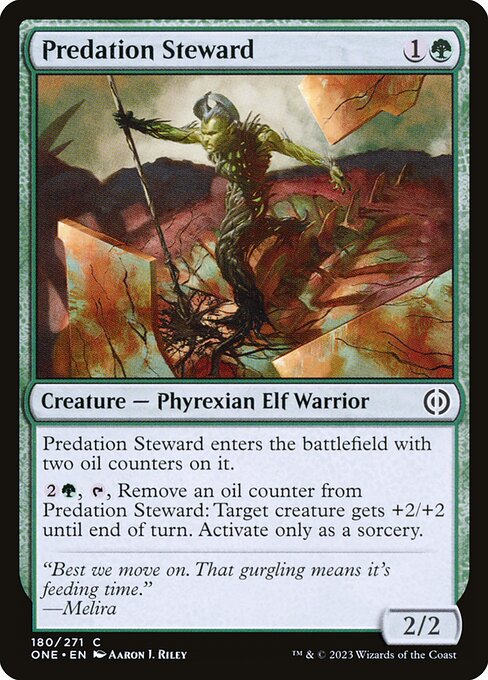
Predation Steward
Any time a 2/2 for two mana also has late game applications or ways to sink your mana into, it it’s probably a good card. This card is good early. It’s decent late. It can break boardstalls, get proliferated onto, has oil-counter synergies with other cards, and it’s ability is even stronger in a set with toxic. Two mana goes a long way here.
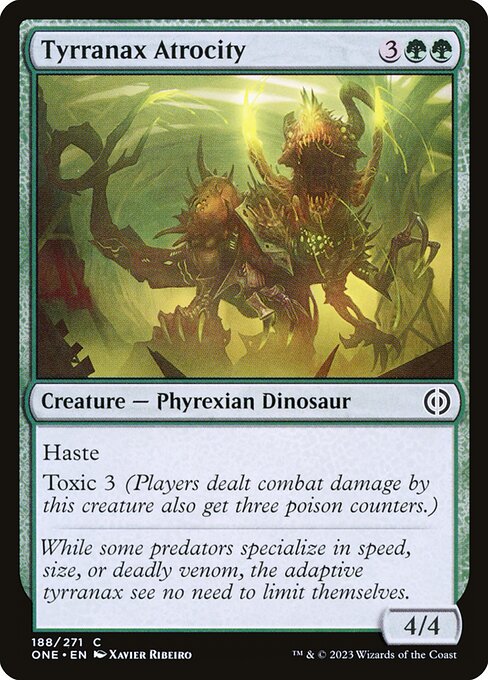
Tyrannax Atrocity
The more limited I play these days, the fewer cards I find I am willing to play that cost more than four mana. I think in general if you’re playing a card that is >four mana in Limited, it has to do at least one of two things. It either needs to stabilize you in spots where you are behind, especially when you’re on the draw, or it needs to be a card that demands an answer from your opponent or it will win the game on its own. I definitely will be sideboarding this card out of my deck a lot when I am on the draw, especially versus aggressive decks as it does nothing to stabilize.
However on the play for a common, this is extremely powerful for it’s rate and I can imagine a lot of spots where your opponent will have to answer this or will lose. There aren’t a lot of commons I think can boast this power level, and so I think this card is good. But again, don’t think it’s as good as the other cards I’ve mentioned so far in as many spots and five mana is a lot.

Oil-Gorger Troll
Now this is a five drop that can stabilize you. The three life being gained, regardless of having another permanent with an oil counter, will probably be more important in spots where you’re on the draw and trying to stabilize. In decks with many oil counter permanents where this reliably draws you a card, it will always be a welcome addition turn five or beyond. I think this is a fantastic common. However, again with it being five mana, you can only play so many cards in a deck that cost five or more mana. Slots are limited in your curve here. On the play in more aggressive decks you’d much prefer Tyrannax Atrocity, but against control decks with a lot of removal I think both cards are good. One is a threat that replaces itself (troll) and one is a threat that has to be answered (dino)
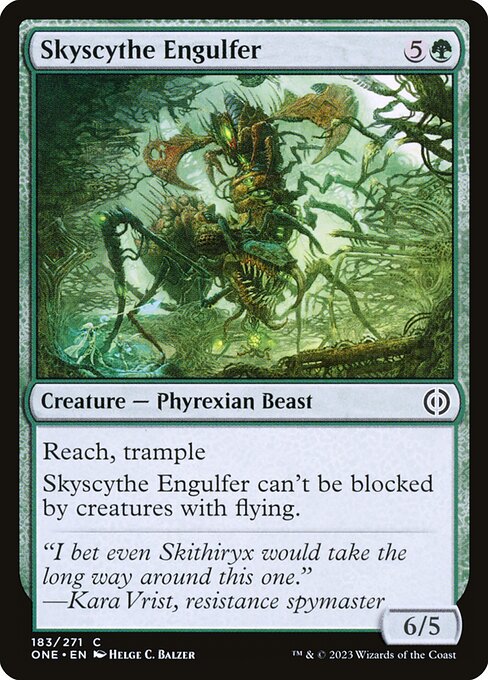
Skyscythe Engulfer
If I don’t like playing too many five mana creatures, I certainly feel even more strongly about not playing too many six drops. In most games of draft (and often sealed) when I’m on the draw vs aggressive decks, I will take out any five or six drop creatures that can’t stabilize me or demand an answer once they hit the battlefield. Cards like Wurmcoil Engine obviously fit the mold of cards I’m never taking out as is Thragtusk (Oil-Gorger Troll’s predecessor).
This card however, even though it certainly will often get killed, might just be good enough to me to keep in in aggressive matchups. This largely due to it being very easy to cast, having reach (a huge stabilizing plus, especially for green decks), and being quite capable of turning the tides on its own. I think six mana is likely too much on the draw for a creature that provides value on ETB and can be answered for far less mana than it costs. But, I’d be okay with maindecking one of these. After all, I’ve maindecked similar cards in the past, such as Colossal Dreadmaw. This card having reach, semi-evasion, and only 1G really pushes it over the top to me as a common six drop creature worth playing in a lot of decks.
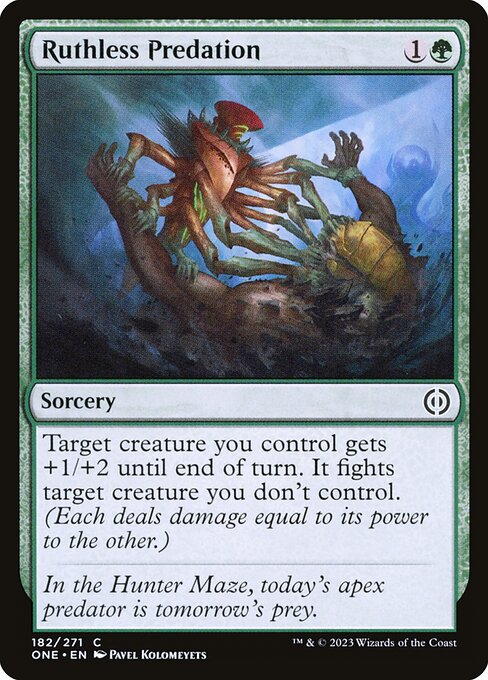
Ruthless Predation
Greens commons get somewhat less exciting here. However, Ruthless Predation (aka Epic Confrontation) seems poised to be as good as advertised and a top green common. Two mana removal that will kill most creatures, and give you a way to push some damage to boot, is a card you can pretty much rely on always. You can play every copy you get, except in the most controlling of control matchups, where they have few creatures and you need to be more threat dense.
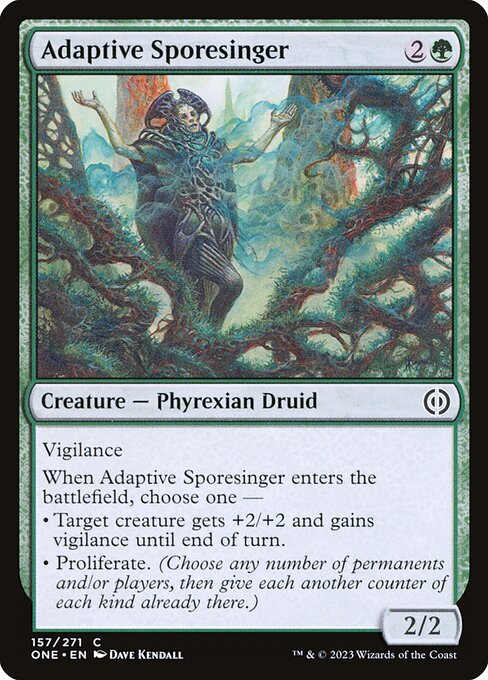
Adaptive Sporesinger
Another modal card. I certainly am not complaining about options. On the play, or even the draw, when you curve two-drop into this it’s a huge tempo swing and can move a race in your favor. Whether on the play or draw, when this is your first play of the game, as a three drop the floor is quite low here. Gray Ogre’s don’t really cut the mustard in Limited these days. I think this is definitely the weakest of all the commons I’ve discussed so far, and a clear tier off from everything else I’ve seen. But a gray ogre in green now has a keyword, as well as the potential to swing races or generate a lot of value. We’re getting so much from a common. Again, the floor I think is the lowest on this card of all the cards discussed so far, but the ceiling is still quite reasonable.
There are more green commons I think can be quite good, and potent even beyond everything I’ve mentioned so far. The uncommons too look outstanding to me. Almost every single one I’ve looked at is either a very efficiently-costed creature with excellent text, or a card that generates value also at a good rate. Good luck to everyone pre-releasing this weekend or attending any limited events in Philadelphia and beyond! My advice: go green, go home happy.
Hugh Kramer (he/him) has always been a Limited man, both in terms of his preferred Magic: The Gathering format and his capacity to understand basic level subjects. Fatherhood may be a new and wonderful endeavor for Hugh, but endeavoring to understand the human condition has always been the main focus of his life…that and food. Mmm. Food.

